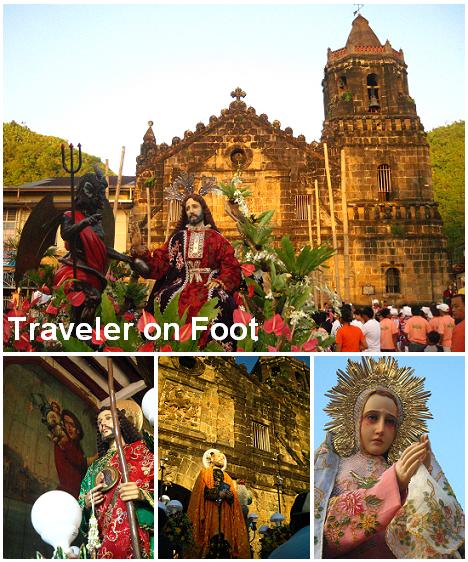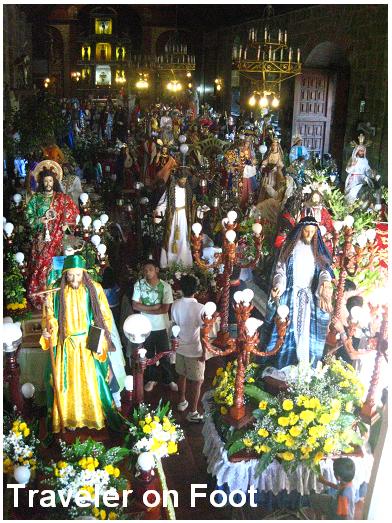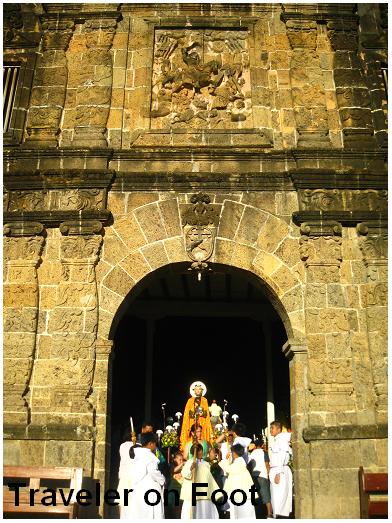
FOLKSY PROCESSIONS. A massive crowd waving Palaspas before an image of Jesus on a donkey called the Humenta is the first procession of the Holy Week. This Palm Sunday Procession recalls Jesus’ entry into Jerusalem. Important Holy Week processions follows on Holy Wednesday for the Via Crucis, on Maundy Thursday for the procession of the Eucharist to the Altar of the Repose, on Good Friday for the funeral procession with the Santo Entierro and on Easter Sunday for the Salubong with the image of the Risen Christ.
In the woodcarving town of Paete, Laguna, a folksy procession is held on Holy Wednesday that brings us back to our ancestral world.

A FESTIVAL OF CARROZAS. Arriving late in the afternoon, local spectators and some eager tourists have already gathered in front of the Paete Church. A fellow blogger, Sidney Snoek has already found a good spot to take his photos.
Inside the centuries-old church of Paete is a festival of carrozas. The pews were purposely removed to give way to the massive carriages bearing the images of saints, via crucis celebrities and tableau based from Biblical scenes. It is amazing to see how the carrozas were lined up inside the church.

THE ROLE OF THE RECAMADERA. Completely decorated with flowers and fully illuminated, standing out from the carrozas are the statues carved by the town’s artisans. Some images date back to the 1700s. Old or newly carved, the statues were exquisite.
Images are entrusted to the recamadera who is in-charge of the cleaning and the dressing of the statue and its carroza for the procession. Traditionally, the recamadera was a matriarch who spends for decorations and the feeding and temporary lodging of those who will join the procession.


HEIRLOOMS AND TRADITIONS. All the statues are family heirloom and are safeguarded at all costs. I have learned from locals that to loose one is considered a grievous offense not only to the family’s reputation but to the entire town as well. During World War II, the heads and hands of the statues were taken to the hills to hide them while the enemy torched the entire town to the ground.
According to local tradition, whoever inherits the statue also inherits a rice field, at a very least a hectare in size. A large portion of the income from the field is allocated for the statues maintenance, its dress, accessories, carroza, lights and flowers when it is taken out on the processions. The rest of the money is spent when the owner of the santo must open their house to all devotees of the statue for a whole day of feasting.

PRUSISYON. I was talking to Sidney, when the ancient tower bells began to toll. I went to my position near the church’s entrance while leaving Sidney somewhere in the courtyard. From the church’s double door the first carroza rolled out followed by the next one. Each float bearing saint or scene is introduced by a voice over.
The Holy Wednesday procession presents scenes and characters from the Stations of the Cross. Traditionally, each carroza is accompanied by guilds based on the image’s attribution. For example, the carroza of the Oracion en el Huerto, a scene in Gethsemene is followed by landlords and orchard owners. Accompanying the Nazareno are jeepney drivers and mechanics much like the scene in Quiapo. The Pieta is followed by workers and owners of funeral parlors. While image of San Pedro is followed by sabungeros, the image of Sta. Veronica with the face of Jesus on a piece of cloth is followed by painters and artists.


EPILOGUE. The procession went through its way across the courtyard and then through the narrow streets of the Paete.
In this day and age when commercialism dominates our traditions and fiestas, an event like the Holy Wednesday Procession in Paete brings us back to our ancestral world.
-Holy Monday 2016
